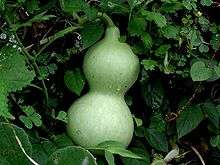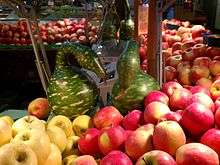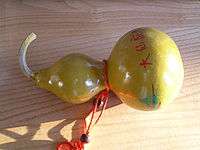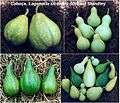Calabash
| Calabash Lagenaria siceraria | |
|---|---|
 | |
| Green calabash on the vine | |
| Scientific classification | |
| Kingdom: | Plantae |
| (unranked): | Angiosperms |
| (unranked): | Eudicots |
| (unranked): | Rosids |
| Order: | Cucurbitales |
| Family: | Cucurbitaceae |
| Genus: | Lagenaria |
| Species: | L. siceraria |
| Binomial name | |
| Lagenaria siceraria (Molina) Standl. | |
| Synonyms | |
| |
The calabash, bottle gourd,[1] or white-flowered gourd,[2] Lagenaria siceraria (synonym Lagenaria vulgaris Ser.), also known by many other names that include: opo squash (from Tagalog: upo), long melon, suzza melon, New Guinea bean and Tasmania bean[3] is a vine grown for its fruit, which can either be harvested young and used as a vegetable, or harvested mature, dried, and used as a bottle, utensil, or pipe. The fresh fruit has a light-green smooth skin and a white flesh. Rounder varieties are called calabash gourds. They grow in a variety of shapes: they can be huge and rounded, small and bottle shaped, or slim and serpentine, more than a metre long. Because bottle gourds are also called "calabashes", they are sometimes confused with the hard, hollow fruits of the unrelated calabash tree, Crescentia cujete, whose fruits are also used to make utensils, containers, and musical instruments.[4] The gourd was one of the first cultivated plants in the world, grown not primarily for food, but for use as water containers. The bottle gourd may have been carried from Africa to Asia, Europe, and the Americas in the course of human migration,[5] or by seeds floating across the oceans inside the gourd. It has been proven to be in the New World prior to the arrival of Christopher Columbus.[6]
Origin and dispersal
It is a commonly cultivated plant in tropical and subtropical areas of the world, now believed by some to have spread or originated from wild populations in southern Africa. Stands of L. siceraria, which may be source plants, and not merely domesticated stands, were reported in Zimbabwe in 2004.[7] This apparent domestication source plant produces thinner-walled fruit that, when dried, would not endure the rigors of use on long journeys as a water container. Today's gourd may owe its tough, waterproof wall to selection pressures over its long history of domestication.[8]
Cultivation
Gourds were cultivated in Africa, Asia, Europe, and the Americas for thousands of years before Columbus' discovery of America. Historically, in Europe,[9] Walahfrid Strabo (808–849), abbot and poet from Reichenau and advisor to the Carolingian kings, discussed it in his Hortulus as one of the 23 plants of an ideal garden.[10][11]
Recent research indicates some gourds have an African origin and that there were at least two unrelated domestications: one that occurred 8,000-9,000 years ago, based on the analysis of archeological samples found in Asia, and a second domestication, which occurred 4,000 years ago, traced from archeological discoveries in Egypt.
The mystery of the bottle gourd – namely that this African or Eurasian species was being grown in America over 8,000 years ago[12] – came about from the difficulty in understanding how it came to be in the Americas. The bottle gourd was originally thought to have drifted across the Atlantic Ocean from Africa to North and South America, but genetic research on archeological samples published by the National Academy of Sciences in December 2005 suggested that it may have been domesticated earlier than food crops and livestock and, like dogs, was brought into the New World at the end of the ice age to the native Paleo-Indians. This study showed that gourds found in American archaeological finds appeared closer to Asian variants than to African ones.[13]
In February 2014, the original hypothesis was revived based on a more thorough genetic study. Researchers examined the entire genome, including the plasmid genome, and concluded that American specimens were most closely related to wild African variants and could have drifted over the ocean several or many times as long as 10,000 years ago.[14]
Nowadays, bottle gourds are grown by direct sowing of seeds or transplanting 15- to 20-day-old seedlings. It prefers well-drained, moist, rich soil. It requires plenty of moisture in the growing season and a warm sunny position sheltered from the wind. It is cultivated in small places such as in a pot, spread on a trellis or roof. In rural areas, many houses with thatched roofs are found covered with the gourd vines. Bottle gourds grow very rapidly and their stems can reach a length of 9 m in the summer, so they need a solid support to climb by the pole or trellis along the stem. If planted under a tall tree, the vine can grow up to the top of the tree. To get more fruit, sometimes farmers cut off the tip of the vine when it has grown to 6–8 feet long. This forces the plant to produce side branches that produce fruit much sooner and more flowers and more fruit. The plant produces white flowers. The male flowers have long peduncles and the females have short ones with an ovary of the shape of the fruit. Sometimes, the female flowers drop off without growing into a gourd due to the failure of pollination if no bee activity occurs in the garden area. To solve the problem, hand pollination can be used.
Crops are ready for harvest within two months; yield ranges from 35–40 m tons/ha.
-

Bottle gourd seeds
-

Lagenaria siceraria var peregrina MHNT
-

Traditional Opo squash grown in garden in An Giang, Vietnam
-

Calabash (Opo squash) flower
-
Calabash bottle gourd, Lagenaria siceraria (synonym Lagenaria vulgaris Ser.), also known as opo squash, in San Rafael, Bulacan, Philippines.
-
Close-up of opo
-

Lagenaria siceraria "geese", Granville Island Public Market, Canada.
-
Upo (bottle gourd or Calabash) with sotanghon
-
Bottle gourds (L. siceraria) on the plant (Lefkada, Greece).
Occasional toxicity
Like other members of the Cucurbitaceae family, gourds contain cucurbitacins that are known to be cytotoxic at a high concentration. The tetracyclic triterpenoid cucurbitacins present in fruits and vegetables of the cucumber family are responsible for the bitter taste, and could cause ulcers in the stomach. In extreme cases, people have died from drinking the juice of gourds.[15][16][17] The toxic cases are usually due to the gourd being used to make juice, which the drinkers attested to being unusually bitter.[18] And in the three lethal cases, the victims were all diabetics in their 50s and 60s.[18]
However, the plant is not normally toxic when eaten and is safe to consume. The excessively bitter (and toxic) gourds are due to improper storage (temperature swings or high temperature) and over-ripening.[19]
To avoid poisoning, it is advised to:[18]
- Taste a small piece of the gourd to make sure it is not unusually bitter, before making juice
- Discard all excessively bitter gourd or juice
- Do not mix the juice of gourds with other juices, such as that of bitter gourd, so as not to mask the taste if it has gone bad
Culinary uses
In Arabic, it is called qara. In Aramaic, it is called kura. In the Talmudic period, the young fruits were boiled, whilst the mature fruits were eaten as dessert. The tender young gourd is cooked as a summer squash.
In Bangladesh, it is called laau (লাউ) or kaddu (কদু).
In Burma, it is known as ဗူးသီး boo thee, a popular fruit; young leaves are also boiled and eaten with spicy hot, fermented fish sauce called nga peet.
In Central America, the seeds of the bottle gourd are toasted and ground with other ingredients (including rice, cinnamon, and allspice) to make the drink horchata. (The calabash tree, Crescentia cujete, is known locally as morro or jícaro; that is another "calabash"). In Colombia and Venezuela, the calabash tree is known as a taparo or totumo (it is another "calabash" plant).
It is frequently used in southern Chinese cuisine in either a stir-fry or a soup. The Mandarin name for calabash is hulu (simplified Chinese: 葫芦; traditional Chinese: 葫蘆; pinyin: húlu) or huzi (Chinese: 葫子; pinyin: húzi). Two common kinds of calabash are sold in Chinese stores: the opo kind, which is elongated but still plump, and mao gua which translates to "hairy squash". It is very similar to opo, but it has hairs, as its Chinese name references. The hairs, although small, can become embedded in the skin, but it is usually safe for adults to handle.
In India, it is known as lauki (लौकी / લૌકી), laau (लाऊ,), dudhi (दूदी / દૂદી) or ghiya (घीया / ઘીયા) in Hindi/Urdu/Gujarati/Bengali/Marathi; Laau (লাউ) (ଲାଉ) in Odia; aal (आल) in Marwari; churakka (ചുരക്ക) in Malayalam; jatilao in Assamese; sorakaaya (సొర కాయ) or anapakaya in Telugu; dudhi-Bhopala (दुधी भोपळा) in Marathi; sorekayi (ಸೋರೆಕಾಯಿ) in Kannada; sajmain in Maithili and Labu (ලබු) in Sinhalese and suraikkaai (சுரைக்காய் colloquilly sorakkay) in Tamil. A popular north indian dish is lauki channa, (channa dal and diced gourd in a semidry gravy). In the state of Maharashtra in India, a preparation similar to lauki channa is popular. However, the skin is removed prior to making the dish. The skin is used in making a dry spicy chutney preparation.
In Italian cuisine, it is known as cucuzza (plural cucuzze).
In Japan, the species is known as hyōtan (瓢箪, 瓢簞) or yūgao (夕顔), with the former word referring particularly to the larger-fruiting variety whose fruits are used mostly for making containers or other handicrafts, and the latter referring to the smaller-fruiting variety whose fruits are more edible. Names used to refer particularly to the fruit of one or another variety of this species include fukube (瓠, 瓢, ふくべ) and hisago (瓠, 匏, 瓢, ひさご). It is most commonly sold in the form of dried, marinated strips known as kanpyō and is commonly used as an ingredient for making makizushi (rolled sushi).
In Korea, it is known as bak (박) or jorongbak (조롱박).
In Nepal, it is called lauka (लौका).
In Pakistan, the green calabash is known as lauki, while the yellow variety is known as kaddu in Urdu.
In the Philippines, it is known as upo (ᜂᜉᜓ).
In Sri Lanka, it is used in combination with rice to make a variety of milk rice (labu Kiribath, ලබු කිරිබත්), which is one of the popular native dishes among Sri Lankans.
In Vietnam, bầu (opo squash), bầu canh, or bầu nậm is a very popular vegetable, commonly cooked in soup with shrimp, meatballs, clams, various fish like freshwater catfish or snakehead fish, or crab. Opo squash is also commonly stir-fried with meat or seafood, or incorporated in hotpot. It is also as a medicine.
The shoots, tendrils, and leaves of the plant may also be eaten as greens.
Cultural uses
Africa

Hollowed-out and dried calabashes are a very typical utensil in households across West Africa. They are used to clean rice, carry water, and as food containers. Smaller sizes are used as bowls to drink palm wine.

Calabashes are used in making the West African kora (a harp-lute), xalam/ngoni (a lute) and the goje (a traditional fiddle). They also serve as resonators underneath the balafon (West African marimba). The calabash is also used in making the shegureh (a Sierra Leonean women's rattle)[20] and balangi (a Sierra Leonean type of balafon) musical instruments. Sometimes, large calabashes are simply hollowed, dried, and used as percussion instruments, especially by Fulani, Songhai, Gur-speaking and Hausa peoples. In Nigeria, the calabash has been used to avoid a law requiring the wearing of a helmet on a motorcycle.[21] In South Africa, it is commonly used as a drinking vessel by tribes such as the Zulus. Erbore tribe children in Ethiopia wear hats made from the calabash to protect them from the sun. Recently, the Soccer City stadium which hosted the FIFA World Cup has been completed and its shape takes inspiration from the calabash.
Caribbean
Calabash is primarily used for utensils, such as cups, bowls, and basins in rural areas. It can be used for carrying water or can be made for carrying items, such as fish, when fishing. In some Caribbean countries, it is worked, painted, and decorated as shoulder bags or other items by artisans, and sold to tourists.
In Jamaica, it is also a reference to the natural lifestyle of Rastafarians. As a cup, bowl, or even water-pipe or "bong", the calabash is considered consistent with the "Ital" or vital lifestyle of not using refined products such as table salt, or using modern cooking methods, such as microwaves. In Haiti, the plant is called kalbas kouran, literally, "running calabash", and is used to make the sacred rattle emblematic of the Vodou priesthood, called an asson. As such, the plant is highly respected. It is also the national tree of St. Lucia.
China
The hulu is an ancient symbol for health.

In the old days, doctors would carry medicine inside it, so it has fabled properties for healing. The hulu is believed to absorb negative earth-based ki (energy) that would otherwise affect health, and is a traditional Chinese medicine cure. Dried calabash is also used as containers of liquids, often liquors or medicines. Calabash gourds were also grown in earthen molds to form different shapes with imprinted floral or arabesque design and dried to house pet crickets, which were kept for their song and fighting abilities. The texture of the gourd lends itself nicely to the sound of the animal, much like a musical instrument. It is a symbol of the Xian immortals.
Hulusi is a kind of flute.
-
_-_2012_Richmond_Folk_Festival.jpg)
A hulusi, the calabash gourd flute or bottle gourd flute, musical instrument
Costa Rica
- Note that "guacal" in Costa Rica refers to C. cujete tree calabash.
The Costa Rican town of Santa Bárbara de Santa Cruz holds a traditional annual dance of the calabashes (baile de los guacales). Since 2000, the activity has been considered of cultural interest to the community, and all participants receive a hand-painted calabash vessel to thank them for their economic contribution (which they paid in the form of an entrance ticket).[22]
Aboriginals throughout the country traditionally serve chicha in calabash vessels to the participants of special events such as the baile de los diablitos (dance of the little fiends).[23]
Hawaii
In Hawaii, a calabash is a large serving bowl, usually made from a hardwood rather than from the calabash gourd as in Maroon cultures. It is used on a buffet table or in the middle of the dining table. The use of the calabash in Hawaii has led to terms like "calabash family" or "calabash cousins", indicating an extended family grown up around shared meals and close friendships.
This gourd is often dried when ripe and used as a percussion instrument called an ipu heke in contemporary and ancient hula.
India
Calabash is used in many string instruments in India as a resonator. Instruments that look like guitars are made of wood, but they can have a calabash resonator at the end of the strings table called toomba. The sitar, the surbahar, the tanpura (south of India, tambura north of India), may have a toomba. In some cases, the toomba may not be functional, but, if the instrument is large, it keeps its place because of its balance function; that is the case of the Saraswati veena. Other instruments like rudra veena and vichitra veena have two large calabash resonators at both ends of the strings table. The Baul singers of Bengal have their musical instruments made out of calabash. The practice is also common among Buddhist and Jain sages.[24]
These toombas are made of dried calabash gourds, using special cultivars that were originally imported from Africa and Madagascar. They are mostly grown in Bengal and near Miraj, Maharashtra. These gourds are valuable items and they are carefully tended; for example, sometimes they are given injections to stop worms and insects from making holes while they are drying, etc.
-
.jpg)
Sitars and one rudra veena (down right)
-

Saraswati veena, the calabash resonator not always functional but keeps its place because of the balancing function.[3]
-

Rudra veena is a large plucked string instrument used in Hindustani classical music, one of major types of veena played in Indian classical music, it has two calabash gourd resonators.[3] Similar is vichitra veena, also with two large resonators.
-

Ek tara (one chord) resonator made from a calabash gourd
- ^ India-instruments.de sitar
- ^ http://www.ashokpathak.com/Ashok_Pathak_pages/Ashok_Pathak_surbahar.html
- ^ a b http://www.buckinghammusic.com/veena/veena.html
- ^ Daily Music. Tambura/tanpura.
Hindu ascetics (sadhu) traditionally use a dried gourd vessel called the kamandalu. The juice of bottle gourd is considered to have medicinal properties and to be very good for health.
In parts of India, the dried, unpunctured gourd is used as a float (called surai-kuduvai in Tamil) to learn swimming in rural areas.
Mexico
- Note that "jícara" refers to the Crescentia cujete calabash
In many rural parts of Mexico, the calabash is dried and carved hollow to create a bule or a guaje, a gourd used to carry water around like a canteen. The gourd cut in half, called jícara, gave the parallel name to a clay cup jícara.
South America
In Brazil, Chile, Argentina, Uruguay, and Paraguay, calabash gourds are dried and carved into mates (Quichua word, adopted in Spanish language), the traditional container for mate, the popular caffeinated, tea-like drink brewed from the yerba mate plant (the container is called cuia, porongo, or cabaça in Brazil). In the same region, it is called mate as is also the calabash from which the drinking vessels are made, and, in Peru, (where the practice of drinking mate is not adopted,) it is used in a popular practice for the making of mate burilado; "burilado" is the technique adopted for decorating the mate calabashes. In Brazil, gourds also commonly used as the resonator for the berimbau, the signature instrument of capoeira, a martial art/dance developed in Brazilian plantations by African slaves. The calabash gourd is possibly mankind's oldest instrument resonator.
-

L. siceraria "mate" type.
-
.jpg)
Mate carved and decorated as a drinking container (also called mate, and the infusion also called mate).
-

Mate burilado in Peru
-
Berimbau, musical instrument in Brazil: The gourd functions as a resonator.
In the region where Incas lived (Peru, Bolivia, Ecuador), calabash gourds are known to have been used for medicinal purposes for over a thousand years by Andean cultures. The Inca culture applied folklore symbology to gourds to pass down from one generation to another, and this practice is still familiar and valued.
Bowls made of calabash were used by indigenous Brazilians as utensils made to serve food, and the practice is still retained in some remote areas of Brazil (originally by populations of various ethnicities, origins and regions, but nowadays mainly the indigenes themselves).
Venezuela
- Note that "totuma" refers to the vessel made of C. cujete calabash.
Former president Hugo Chávez of Venezuela suggested Venezuelans avoid showers longer than three minutes.[25][26] Critics of Chavez ridiculed this by reductio ad absurdum, ironically suggesting the use of a totuma to bathe (although Chavez himself did not suggest this),[27][28] inferring that people have to bathe with "a totuma of water", the quantity of water that only one totuma can hold. It is a joke because it exaggerates the original words, because a totuma is a device that carries very little quantity of water, not enough for bathing (not even to get wet).
Other uses
Additionally, the gourd can be dried and used to smoke pipe tobacco, usually constructed with a meerschaum lining holding the lit tobacco within the gourd. A typical design yielded by this squash is recognized (theatrically) as the pipe of Sherlock Holmes, but Doyle never mentioned Holmes using a calabash pipe. It was the preferred pipe for stage actors portraying Holmes, because they could balance this pipe better than other styles while delivering their lines. See, Smoking pipe (tobacco)#Calabash.
References
- ↑ "Lagenaria siceraria". Natural Resources Conservation Service PLANTS Database. USDA. Retrieved 22 January 2016.
- ↑ "BSBI List 2007". Botanical Society of Britain and Ireland. Archived from the original (xls) on 25 February 2015. Retrieved 2014-10-17.
- ↑ http://www.thekitchn.com/ingredient-spotlight-cucuzza-s-94464
- ↑ See Sally Price, "When is a calabash not a calabash" (New West Indian Guide 56:69-82, 1982).
- ↑ Erickson, David L.; Smith, Bruce D.; Clarke, Andrew C.; Sandweiss, Daniel H.; Tuross, Noreen (20 December 2005). "An Asian origin for a 10,000-year-old domesticated plant in the Americas". PNAS. 102 (51): 18315–18320. Bibcode:2005PNAS..10218315E. doi:10.1073/pnas.0509279102. PMC 1311910
 . PMID 16352716. Retrieved 17 November 2009.
. PMID 16352716. Retrieved 17 November 2009. - ↑ "Cucurbitaceae--Fruits for Peons, Pilgrims, and Pharaohs". University of California at Los Angeles. Retrieved September 2, 2013.
- ↑ Decker-Walters, D.S.; Wilkins-Ellert, M.; Chung, S.-M.; Staub, J.E. (2004). Discovery and genetic assessment of wild bottle gourd [ Lagenaria siceraria (Mol.) Standley, Cucurbitaceae] from Zimbabwe. mbe.oxfordjournals.org – Economic Botany 58. pp. 501–508.
- ↑ Decker-Walters, D.S.; Wilkins-Ellert, M.; Chung, S.-M.; Staub, J.E. (2005). Reconstructing the Origins and Dispersal of the Polynesian Bottle Gourd (Lagenaria siceraria). Proceedings of the SMBE Tri-National Young Investigators' Workshop 2004. pp. 58, 501–508.
- ↑ Gemüse des Jahres 2002: Der Flaschenkürbis (in German). Schandelah: VEN – Verein zur Erhaltung der Nutzpflanzen Vielfalt e.V. 2002.
- ↑ Strabo, Walahfrid (2000). De cultura hortorum (in Latin and German). Näf,W.; és Gabathuler,M. (ford.). ISBN 3-7995-3504-7.
- ↑ Walahfrid Strabo (2002). De cultura hortorum sive Hortulus VII Cucurbita (in Latin). Fachhochschule Augsburg: bibliotheca Augustana.
- ↑ White, Nancy (2005). Nancy White University of South Florida – South American Archaeology: Archaic, Preceramic, Sedentism. Bloomington: Indiana University Bloomington MATRIX project.
- ↑ Erickson, David L.; Smith, Bruce D.; Clarke, Andrew C.; Sandweiss, Daniel H.; Tuross, Noreen (2005). An Asian origin for a 10,000-year-old domesticated plant in the Americas. Proceedings of the National Academy of Sciences.
- ↑ "Transoceanic drift and the domestication of African bottle gourds in the Americas", Kistler et al, Proceedings of the National Academy of Sciences, February 10, 2014
- ↑ Adhyaru-Majithia, Priya (13 March 2010). "Not all bitter veggies are good, they can kill you: Doctors". DNA. Bhaskar Group. Archived from the original on 9 July 2010. Retrieved 9 July 2010.
- ↑ Chandra, Neetu (9 July 2010). "Toxin in lauki kills diabetic city scientist". India Today. Living Media. Archived from the original on 9 July 2010. Retrieved 9 July 2010.
- ↑ "Bitter 'lauki' juice can kill you". Times of india. Living Media. 28 June 2011. Retrieved 28 June 2010.
- 1 2 3 Indian Council of Medical Research Task Force, 2011, Gastrointestinal toxicity due to bitter bottle gourd
- ↑ 2011, Evaluation of acute and subchronic toxicity of lagenaria , Indian Journal of Gastroenterology
- ↑ image at Joseph Opala, "Origin of the Gullah", yale.edu.
- ↑ "Nigeria bikers' vegetable helmets". BBC News. 6 January 2009.
- ↑ "Baile del Guacal" [Dance of the Calabash]. La Nación (in Spanish). 1 July 2010.
- ↑ Parrales, Freddy (29 January 2011). "Rey Curré se encendió con el baile de los diablitos" [Rey Curré was ignited with the dance of the little fiends]. La Nación (in Spanish).
- ↑ Landsberg, Steven. "The History of an Indian Musical Instrument Maker".
- ↑ "No more singing in the shower: Chavez urges Venezuelans to limit their wash to three minutes amid water shortages". Daily Mail. London. 22 October 2009.
- ↑ Chavez y el comunismo on YouTube
- ↑ La totuma endógena | Artículos Laureano Márquez. Laureanomarquez.com. Retrieved on 2013-08-16.
- ↑ Como hacer Totuma-Ducha comunista on YouTube
External links
| Wikimedia Commons has media related to Lagenaria siceraria. |
- Multilingual taxonomic information at the University of Melbourne
- Calabashes used for flotation and to store fish during huge Nigerian fish festival
- Brief discussion of the species, uses, ecology, and etymology of generic and specific names.

.jpg)